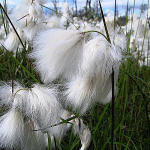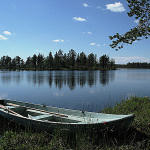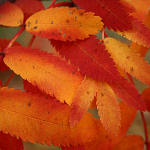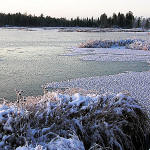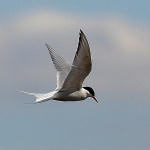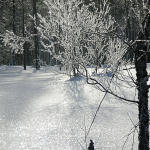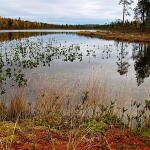

Home
Area
Vätsäri
Övre Pasvik
Pasvik Zapovednik
Nature
Geology
Climate
Water system
Flora
Fauna
Culture
Population
Religion
Sources of livelihood
Old ways of life
Time of industrialism
History
Stone Age
Early Metal Age
Late Metal Age
Middle Ages
Towards modern times
Timeline
Cooperation
Nature monitoring
Nature tourism
Publications
Contacts
Visit Pasvik-Inari
Guidelines
Regulations
News
Links
Climate
The severe northern conditions
The climatic conditions of the northern Europe are harsh both for plants and for animals. The summer is short and the snow coved stays for months. In Pasvik-Inari, the difference between the average temperature of the coldest and warmest month is ca 28°C. On the sunny slopes the ground temperature may raise over 40°C while it may decrease under -40°C in frosty winter. The yearly precipitation in Pasvik River valley is ca 200-500 mm. Approximately half of the rain falls during the growing season. Only tough-lived organisms can survive the great variation in temperatures and the stress caused by drainage.
Short period of blooming
The growing season lasts only for 110-120 days. During the warmest month, July, the temperature usually rises over 25°C. The summers are light and the sun does not set for two months. The organisms inhabiting the northern river valley have adapted to the short summer. Some plants are neutral to the length of the day. Long day plants, on the other hand, thrive in the north. Some of them are photosynthetic even during the night.
Also animals need to take advantage of the short, bright summer and stock their winter supplies. Not only the brown bear (Ursus arctos) creates a thick fat layer under the skin for winter, several other animals also need the energy of winter supplies to survive the cold. For example, the importance of summer pastures are crucial for winter survival of the reindeers (Rangifer tarandus) is considerable.
Coloured autumn days
The shortening days at the end of the summer are a sign of the approaching winter. The plants start to prepare for the winter by preserving the compounds produced during the summer. Green leaves turn yellow, red and brown.
Most birds escape the winter by moving far south, while some species stay and wait for the snow. Not all animals to escape the cold and they need to prepare themselves in other ways. Tits gain weight during the autumn, while willow grouse (Lagopus lagopus) and hare (Lepus timidus) change into their white winter costume.
Life on the snowdrifts
During the darkest period of the winter the sun does not rise above the horizon for nearly two months. In January and February, the temperature may decline under -40°C. Without a thick winter fur or a warm nest the mammals would not survive the coldest period. The fat under the skin brings warmth and extra energy. Many animals such as the Siberian Jay (Perisoreus infaustus) and the squirrel (Sciurus vulgaris) use the food they have collected and hidden during the summer.
Early spring lightens the white land and brightens the life. Small insects, such as wingless snow flies (Chionea) or winter crane flies (Trichoceridae) may be seen on the snow drifts. A traveller on skies may be surprised by a hairy larva of a ruby tiger moth (Phragmatobia fuliginosa) seeking a place to pupate.
The travellers return
The snow cover melts slowly during May but snowy lags persist. The ice on the ground stays cold until the warm June. Upon exposure to the sun the plants start to grow quickly. The approaching summer affects the animals. Courtship begins already in the early spring when the owls begin to holler and the Capercaillies (Tetrao urogallus) start their display. The bird fauna is multiplied when the migratory birds return. The Arctic stern (Sterna paradisaea) has the longest trip back to the north all the way from Antarctic.
